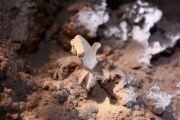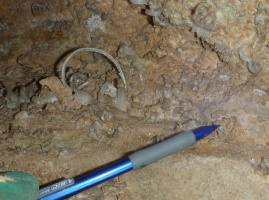Gypsum (Inventory)/Flower
From LagWiki
The Flower field is used to record stations where gypsum flowers are found.
Gypsum flowers form when pyrite oxidizes just below the surface of exposed bedrock. They grow outward in curving fronds that appear to have been squeezed out of the rock like toothpaste. They form fronds which curl and separate, spreading to make something that resembles a flower. They are usually dry and white in color but can be stained, particularly with rust colors. Gypsum flowers are usually tiny to small but they can grow to be large with fronds of several feet. The diameter of each frond can vary from tiny to several inches on larger flowers. Gypsum flowers sometimes appear as single fronds, so the flower-like shape is not a requirement. Look for gypsum flowers with careful and close examination of all surfaces, especially exposed bedrock, breakdown and soils which might be just a thin layer over bedrock. Also look for them among gypsum crusts as they often occur together.
See also
References
- Palmer, Arthur N. (2007) Cave Geology CAVE BOOKS, Dayton, OH p 291 ISBN-13: 978-0-939748-66-2, ISBN-10: 0-939748-66-5
- Hill, Carol; Paolo Forti (1997) Cave Minerals of the World (Second Edition ed.) National Speleological Society p 63 ISBN: 1-879961-07-5


